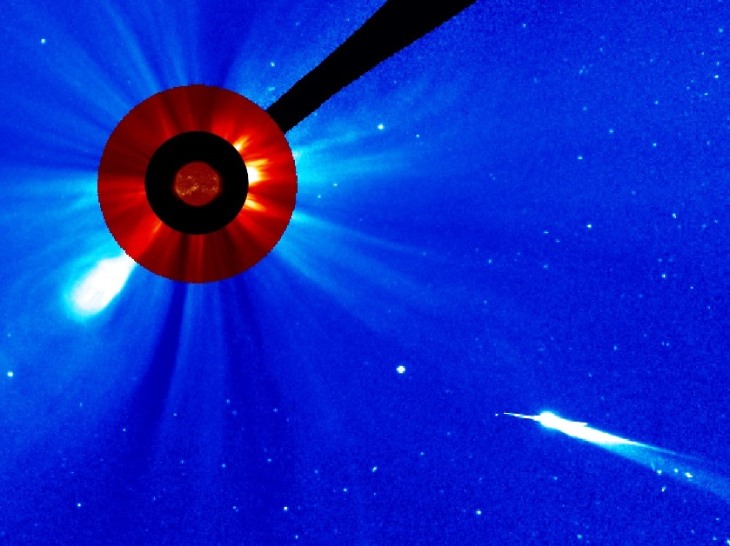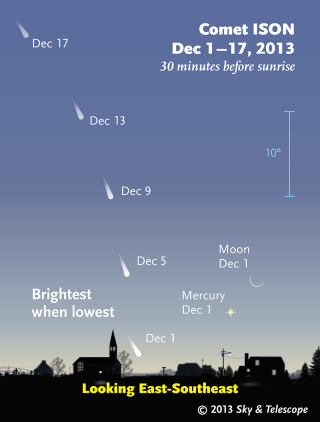E é sabido desde a Antiguidade - e com muitos medos escatológicos na Idade Média - que a passagem/avistamento de cometas está associada a eventos geomorfológicos, climáticos, electromagnéticos de excepção (parece-me que o Ison não se importa que lhe atribuam as culpas dos males presentes :-) e até talvez leve com compaixão todos esses receios da consciência de massas, coincidindo com o dia de Acção de Graças dos Americanos)
Comet ISON brightens as it closes in on Thanksgiving's solar climax

NASA / SDO / ESA / SOHO / Helioviewer.org
A composite image, based on data from NASA's Solar Dynamics Observatory
and the Solar and Heliospheric Observatory, shows the sun and its
coronal activity as well as Comet ISON approaching from the lower right.
For more than a year, Comet ISON has been taking skywatchers on a roller-coaster ride, but the most dramatic thrill is coming up on Thursday — and the prospects look good for a spectacular show.
Over the course of less than a day, the comet's brightness "has increased by at least a factor of four, and indications are it may be closer to a factor of 10," the NASA Comet ISON Observing Campaign reported on Wednesday.
When we last checked in with what was once called the "comet of the century," ISON was heading toward the sun at the same time that a solar storm was pushing outward. Karl Battams, an astrophysicist at the Naval Research Laboratory who's part of the observing campaign, was almost gleeful over the prospect that the cosmic storm cloud would interact with the comet's tail.
However, it turned out that the cloud of electrically charged particles, also known as a coronal mass ejection, had no significant effect. "The source of the cloud is a farside active region, which is not directly facing the comet," SpaceWeather.com's Tony Phillips reported.
A series of images from the SOHO spacecraft shows Comet ISON approaching the sun as a solar storm sweeps outward.
Battams reported that the comet had brightened to around magnitude +0.5, which is as bright as the star Betelgeuse in the "shoulder" of the constellation Orion. What's more, ISON appears to be behaving like a classic sungrazing comet. That is, it's behaving like Comet Lovejoy (C/2011 W3), which weathered its whirl around the sun and dazzled the Southern Hemiphere two years ago.
"We cannot comment on whether the nucleus is intact or not, but our analyses indicate that its rate of brightening is directly in line with that we have experienced with other sungrazing comets," Battams wrote. "This has no implications on its chances of survival."

Sky & Telescope
Assuming that Comet ISON survives, here's where to look for it in
pre-dawn skies during December. The Sky & Telescope chart is drawn
for skywatchers near 40 degrees latitude (Denver, New York, Madrid) but
should serve for most northern temperate latitudes. The blue 10-degree
scale is about the width of your fist held at arm's length. Check
SkyandTelescope.com for more charts and updates.
Battams and his colleagues on the observing campaign advised solar observatories to watch for the comet to get even brighter as it rounds the sun. They also advised casual observers not to try looking for ISON in the sky over the next couple of days, due to the risk of eye damage. (But if you're set on trying, Sky & Telescope's Alan McRobert provides an observing guide.)
The best bet is to monitor the comet's passage online.
The climax comes around 1:37 p.m. ET Thursday, when ISON zooms within 730,000 miles (1.2 million kilometers) of the sun at a top speed of 850,000 mph (380 kilometers per second). For expert commentary and views from NASA's Solar Dynamics Observatory, tune into a Google+ Hangout that's scheduled from 1 p.m. to 3:30 p.m. ET Thursday. You'll hear from Battams as well as solar physicists C. Alex Young and W. Dean Pesnel, plus Phil Plait, the astronomer behind the "Bad Astronomy" blog.
SDO images and movies will also be posted to NASA's Comet ISON Perihelion website. You can keep tabs on the images from the Solar and Heliospheric Observatory by checking the SOHO website (but don't be surprised if the Web traffic is as frantic as an airport before Thanksgiving). Comet ISON is also popping up in images from NASA's sun-watching STEREO spacecraft. NASA offers loads of information and imagery on its Comet ISON portal page.
Other sources for ISON pictures include this Flickr photo pool and SpaceWeather.com's gallery.
If the comet survives intact — or even if it takes a beating, as Lovejoy did in 2011 — you can expect ISON to make a spectacle of itself starting in early December. Northern Hemisphere skywatchers would have the best vantage point: The comet would appear in east-southeast skies, just before the sun comes up. As the month progresses, ISON would be visible higher and higher in the sky — and eventually, it could be seen in western skies after sunset as well as eastern skies before sunrise.
But we're getting ahead of ourselves: Let's find out on Thanksgiving Day whether ISON turns into a triumph ... or a turkey.
Update for 5:10 p.m. ET: Battams and his colleagues are at the Kitt Peak National Observatory in Arizona to keep tabs on ISON, and he emailed this dispatch:
"It's crazy busy with a bunch of film crews and science crews, but it's tremendous fun :)Update for 6:30 p.m. ET: In his latest blog update, Battams addresses a number of frequently asked questions, including this one: "Is ISON a threat to Earth?"
"I've not seen any tail effects that get me excited, but I really haven't had chance to use any of the processing methods that would highlight those. I see no evidence of a disconnect.
"Words of wisdom? Don't step away from the computer screen! We really have zero idea of what is going to happen over the next 48 hours. ISON has stubbornly refused to conform to any preconceptions we've had of it, and I see no reason why it will start playing ball now! No one knows how this story is going to end, but either way it's a real cliffhanger!!"
"I know many of you might roll your eyes here, but some people are genuinely concerned. So, for the record, Comet ISON will never be any kind of threat to Earth WHATSOEVER. On Dec. 26 is will pass about 0.44AU from Earth, which is about the same distance that Venus sits at. There is a possibility in January that Earth might pass through ISON's tail but it is critical to realize that Earth does this all the time. Every meteor shower we see — and there are lots of them — is a result of Earth passing through a debris trail in space. They are completely harmless. I really don't think that we will even notice a meteor shower in our skies but if we do, it will only be a handful of shooting stars every few hours. Barely noticeable and completely inconsequential."
For updates on Comet ISON, keep tabs on Space.com, the Comet ISON Observing Campaign, Hubblesite's ISONBlog, SpaceWeather.com and the websites for Astronomy Magazine and Sky & Telescope. On Twitter, follow @ISONUpdates, @CometISONnews, @CometISON2013, @SungrazerComets and @Cosmos4u.
Alan Boyle is NBCNews.com's science editor. Connect with the Cosmic Log community by "liking" the log's Facebook page, following @b0yle on Twitter and adding the Cosmic Log page to your Google+ presence. To keep up with Cosmic Log as well as NBCNews.com's other stories about science and space, sign up for the Tech & Science newsletter, delivered to your email in-box every weekday. You can also check out "The Case for Pluto," my book about the controversial dwarf planet and the search for new worlds.
